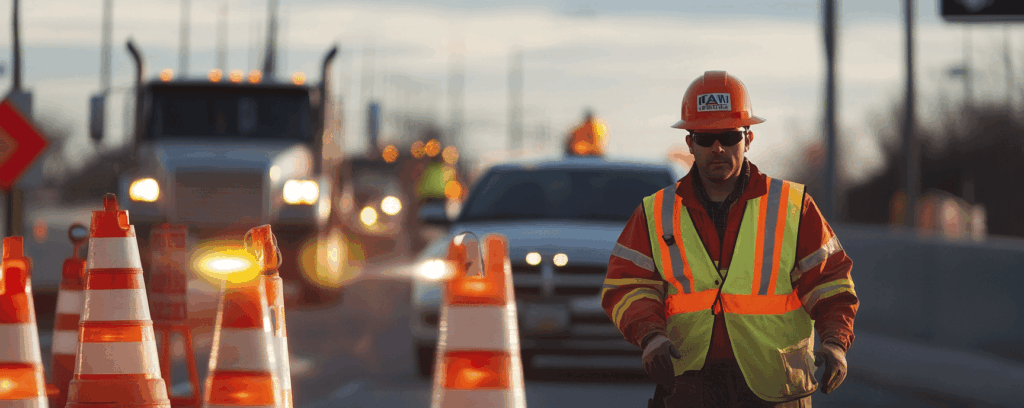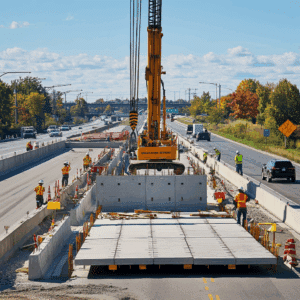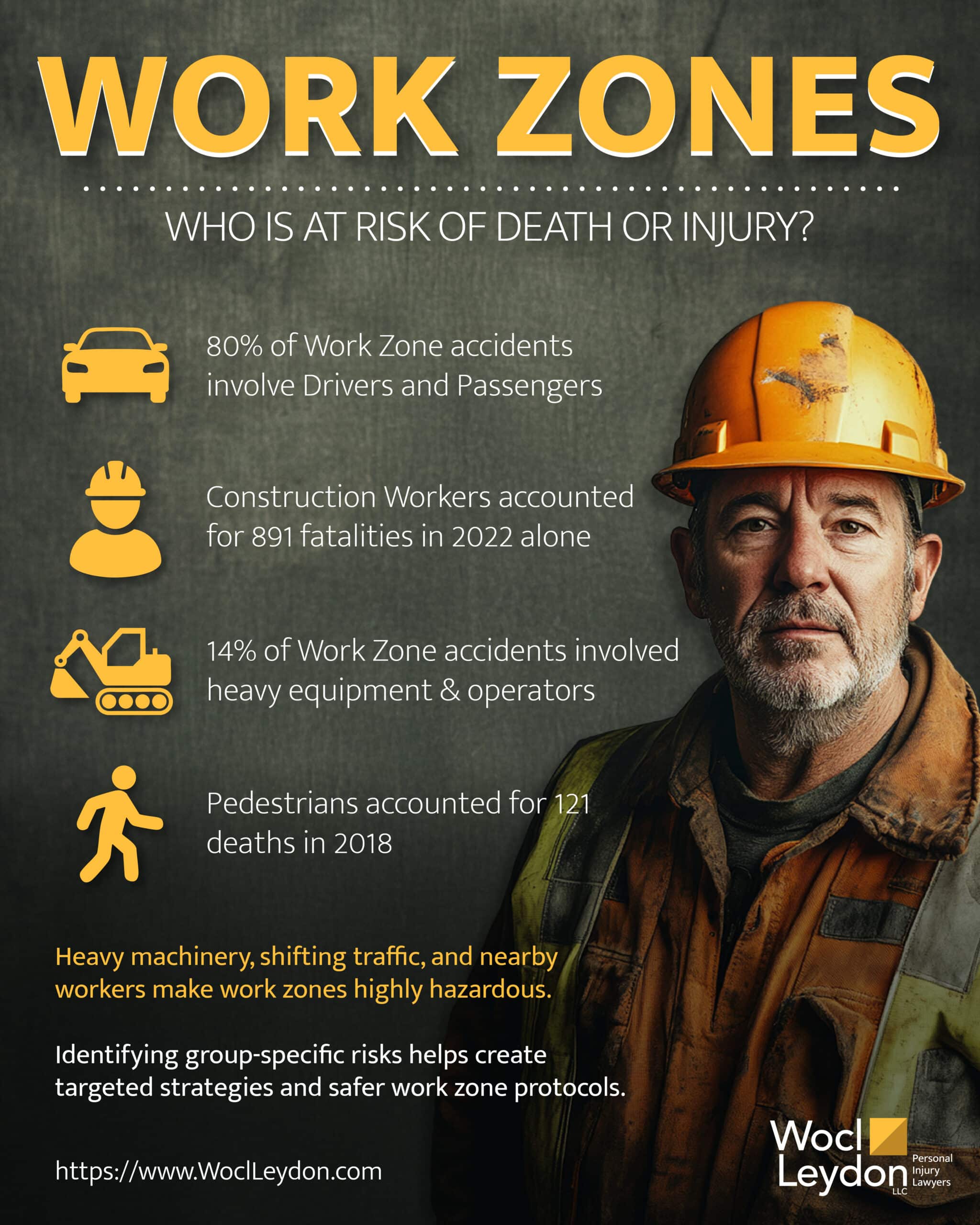Who Is Most Likely to Be Injured or Killed in a Work Zone-Related Crash? Key Facts & Safety Tips
Last updated Thursday, April 24th, 2025

Drivers and construction workers are the most at risk for injury or death in work zone crashes, as they are often the individuals who are most likely to be injured or killed in a work zone-related crash. Motorists make up 80% of the fatalities, and construction workers often face dangerous conditions with heavy machinery and traffic. Keep reading to understand these risks and learn how to stay safe.
Key Takeaways
- Drivers, construction workers, and pedestrians are the most vulnerable groups in work zone-related crashes, with motorists accounting for 80% of fatalities.
- Effective safety measures, such as advanced warning signage, speed limit reductions, and worker training, are essential to mitigate risks in work zones.
- Departments of Transportation are implementing innovative strategies, including improved communication and new construction methods, to enhance safety and reduce work zone-related accidents.

Get Your FREE Case Review,
In Person or Virtually Online
High-Risk Groups in Work Zone Crashes
Work zones are perilous environments where multiple groups face significant risks. Drivers, construction workers, and pedestrians are particularly vulnerable to accidents and work zone fatalities in these areas. In 2022 alone, there were 742 fatalities among drivers and passengers in work zones, slightly down from 784 in 2021. This statistic underscores the high stakes involved in navigating these work zone-related zones safely.
High-risk groups in work zone crashes include:
- Motorists, who account for 80% of fatalities in these incidents
- Construction workers, with approximately 891 fatalities occurring in construction zones in 2022, many involving workers struck by vehicles in a crash
- Pedestrians, with 122 pedestrians losing their lives in work zone incidents in 2018, 38% of whom were workers engaged in job-related tasks
The presence of heavy machinery, changing traffic patterns, and the proximity of workers to moving vehicles create a volatile environment. Nearly half of all worker fatalities in construction zones are due to runovers or backovers by vehicles, while collisions involving construction equipment account for 14% of worker fatalities in highway work zones. These statistics highlight the critical need for heightened safety measures and awareness.
Understanding the specific risks each group faces can help in devising targeted strategies to mitigate these dangers. By focusing on the high-risk groups and the causes of work zone accidents, we can develop more effective safety protocols to protect everyone involved.
The Vulnerability of Construction Workers

Common injuries for construction workers in work zones include those from falling objects and equipment malfunctions. The risk of accidents increases as highway work is often conducted alongside busy traffic, especially during night hours, to alleviate congestion. High-visibility safety apparel is required for workers in road construction zones to enhance their visibility and reduce accidents, especially for those who may become injured.
In 2010, there were 106 reported fatalities at road construction sites, underscoring the significant dangers faced by workers. These statistics highlight the need for rigorous safety protocols and continuous monitoring to protect workers. Ensuring that workers have access to the necessary safety gear and training can significantly reduce the risk of accidents and injuries in these hazardous environments.
Motorists: A Significant Portion of Casualties
Motorists represent a substantial portion of casualties in work zone incidents. In 2022, speeding was a contributing factor in 34% of fatal work zone crashes, up from 32% in 2021. Rear-end collisions accounted for 21% of fatal work zone crashes in 2022, slightly decreasing from 23% in the previous year.
The vulnerability of commercial drivers, including other drivers operating large trucks, is particularly notable in work zone accidents. These drivers often face additional challenges, such as navigating through narrow lanes and dealing with sudden changes in traffic patterns. The presence of heavy machinery and workers in close proximity further complicates the situation, as they must work closely with the evolving conditions.
Motorists must be vigilant and responsive to changing road conditions and traffic signs to avoid accidents. The high percentage of pedestrian fatalities in work zones involving motor vehicles encroaching into road work areas highlights the need for strict adherence to traffic rules and speed limits. By understanding the risks and taking proactive measures to stay alert, motorists can significantly reduce the likelihood of accidents and protect both themselves and others in their car.

Get Your FREE Case Review,
In Person or Virtually Online
Pedestrians in Work Zones
Pedestrians face significant risks in work zones due to various factors, including the presence of construction activities and traffic. Up to 38% of pedestrian fatalities in work zones involve highway workers. This statistic underscores the need for implementing protective measures to improve safety for pedestrians in these areas.
Only 15% of pedestrian fatalities in work zones occurred at or near intersections, indicating that many incidents happen away from typical crossings on the roadway. This underscores the unpredictability and danger of work zones for pedestrians.
There is a critical need for enhanced safety protocols, such as better signage, physical barriers, and increased awareness campaigns, to protect pedestrians and save lives while reducing fatalities and vital data collection.
Leading Causes of Work Zone Accidents
Speeding and reckless driving significantly increase the chances of accidents in work zones. Distractions such as texting while driving severely hamper a driver’s ability to respond to hazards in these areas. Failing to heed traffic signs can lead to dangerous situations and collisions, further complicating the already hazardous environment of work zones, especially as traffic speeds increase.
Tailgating is a common issue in work zones, as it diminishes reaction time and is a leading cause of rear-end collisions. Impairment from alcohol or drugs notably decreases a driver’s judgment and reaction speed, posing serious risks in work zones. Driver fatigue can dramatically lower alertness, contributing to an increased likelihood of accidents.
Understanding these leading causes can help in developing targeted interventions to reduce accidents. By addressing these behaviors and encouraging safer driving practices, we can create a safer environment for everyone in work zones.
Impact of Poor Weather Conditions
Adverse weather conditions, like rain or fog, can exacerbate risks in work zones by reducing visibility and making roads slippery. Heavy rains can cause visibility issues and flooding, both of which exacerbate safety risks in construction zones. Wet or icy surfaces can lead to decreased vehicle control, contributing to higher incidences of rear-end collisions.
High winds can destabilize construction materials and tools, further elevating hazards for workers and motorists in work zones. The combined impact of reduced visibility and compromised road conditions due to poor weather creates a hazardous environment in work zones.
Proper planning and enhanced safety measures are essential to mitigate these risks and ensure the safety of all road users.
Legal Consequences and Responsibilities for Drivers
Drivers are often held liable for accidents in work zones due to their expected responsibility to drive safely. Severe or fatal injuries resulting from work zone accidents can lead to criminal charges against the at-fault driver. Insurance premiums for drivers who cause work zone accidents may significantly increase or lead to being dropped by their insurer.
Adherence to traffic laws is crucial for drivers in work zones to prevent accidents and ensure safety in their daily lives. Understanding how they can contribute to the legal consequences and responsibilities can encourage drivers to be more cautious and attentive, ultimately reducing the number of accidents in work zones.
Safety Measures to Protect High-Risk Groups
Effective work zone safety measures include:
- Using advanced warning signs that inform drivers of upcoming changes
- Implementing changeable message signs that provide real-time updates on traffic conditions and work zone activities, significantly improving driver awareness
- Conducting work zone education campaigns that aim to raise awareness among motorists and improve safety for both drivers and construction workers
The implementation of physical barriers helps to separate construction activities from traffic, enhancing safety. Regular enforcement of reduced speed limits in work zones significantly reduces the risk of accidents. Speed limit reductions and variable speed limits in work zones are effective strategies for enhancing safety for workers and motorists.
Providing adequate training for workers on safety protocols is essential to minimizing hazards in work zones. By implementing these safety measures, we can protect high-risk groups and create a safer environment in work zones, ensuring workers’ safety.
How Departments of Transportation Are Improving Safety

Innovative construction methods, such as using precast materials, help reduce the duration of projects and minimize disruptions. Lane rental charges incentivize highway contractors to complete work quickly, reducing delays and the time roads are obstructed. Public information strategies, such as media alerts and community task forces, are critical for keeping the public informed about work zone impacts.
Weather-related challenges necessitate additional safety planning and enhanced communication protocols at construction sites.
These initiatives by the Department of Transportation aim to improve safety and reduce the risks associated with work zones in engineering, supported by the government.
Get Legal Help After a Work Zone Accident
After a work zone accident, seeking legal assistance is crucial for navigating the complexity of compensation claims. Legal assistance can significantly influence the outcome of compensation claims related to work zone accidents. Victims of work zone crashes are encouraged to pursue their legal rights to ensure that they receive fair compensation for their injuries and damages.
Having legal representation can lead to better negotiation outcomes and increase the chances of receiving appropriate compensatory awards. If you or a loved one has been involved in an office work zone accident, don’t hesitate to seek professional legal help for employees.
Frequently Asked Questions
What are the majority of people injured and killed in work zone crashes?
The majority of people injured and killed in work zone crashes are drivers and their passengers, accounting for about 80 percent of fatalities. Preventing these accidents involves simple actions like slowing down and obeying traffic signs.
Who is most likely to be killed in a work zone crash?
Drivers and passengers are most likely to be killed in work zone crashes, accounting for four out of five fatalities. This highlights the importance of exercising caution in work zones.
Who is most at risk in work zone crashes?
Drivers, construction workers, and pedestrians are the most at risk in work zone crashes, as motorists alone account for 80% of fatalities. It is imperative for all road users to exercise heightened caution in such environments.
What are the leading causes of work zone accidents?
The leading causes of work zone accidents predominantly include speeding, distracted driving, failure to heed traffic signs, tailgating, impairment from alcohol or drugs, and driver fatigue. Addressing these factors is crucial for enhancing safety in work zones.
How do poor weather conditions impact work zone safety?
Poor weather conditions significantly compromise work zone safety by reducing visibility and creating slippery roads, which heightens the likelihood of accidents and injuries. Therefore, it is crucial to implement safety measures and ensure visibility to protect workers and drivers alike.


